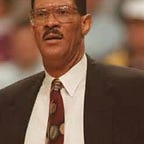How One Botched Procedure Scarred The Nets’ Future
This past Tuesday marked the 5-year anniversary of the trade that was supposed to catapult the New Jersey Nets back into league-wide relevancy. Hindsight is always 20/20 and looking back now, February 23, 2011 is hardly a day to celebrate in Nets history.
In the years leading up until the Deron Williams acquisition, the Nets were a team that seemed in a state of purgatory. Fresh off the dismantling of their successful core of Jason Kidd, Vince Carter, and Richard Jefferson, New Jersey was in desperate need of a franchise talent who the team could build around. Brook Lopez was a promising, young talent, but clearly Devin Harris wasn’t that viewed as “the guy” to quarterback the offense.
There was also the notion of needing a star in place for when the team moved to their new home across the Hudson River. Who better to open the Barclays Center with than arguably the best point guard in the league at the time?
Since that infamous day in February, the Nets’ story has played out somewhat similar to the television show Botched. You know, the reality show that spotlights what could go wrong from plastic surgery. Here was a team that wanted to change its makeup and in the process created an unprecedented mess of epic proportions.
The problem wasn’t just the Deron Williams trade itself, in which they paid a king’s ransom, but everything that transpired over the next few years. This was just the beginning of their identity crisis.
When it was all said and done, the New Jersey — Utah deal ultimately resulted in a swap of Williams for Harris, Derrick Favors, and two future first round picks that turned into Enes Kanter and Gorgui Deng.
The flawed logic in viewing the trade this way is that the Nets probably wouldn’t have drafted Kanter and Deng had they still had those picks. Why would they when they already had a talented, young duo of Lopez and Favors in place for the future? This is where it’s fun (and depressing) to play revisionist history.
As Sean Marks and Adrian Wojnarowski recently discussed on The Vertical Podcast, there are essential steps to take when building a team and culture. Unfortunately, the Nets skipped many of these in their quest to capture the New York market and join the NBA’s elite when the team moved to Brooklyn.
The chart below shows the Nets’ picks that were given away, the players who were selected, and who was still available at the time. This is not just the surrendered picks from the Deron deal but also the subsequent blockbusters (Gerald Wallace, Joe Johnson, and Paul Pierce/Kevin Garnett) made to appease and support the franchise point guard.
As I once wrote, the excitement with the “youth movement” heading into this season was somewhat ironic because it seemed as if the Nets brass believed they had to come to Brooklyn with a team ready to contend. That in order to build and sustain a passionate fan base would be by assembling a super team ready to win now as opposed to going through the growing pains an upstart team experiences.
Now imagine what could’ve been had the Nets stayed the course and utilized the bevy of future assets the team had. If we can all agree with Favors and Lopez already in place, the Nets would’ve addressed their backcourt and wings over the next few drafts. Wouldn’t Devin Harris have been a sufficient placeholder for a rebuilding organization over that time until their future floor general was ready to take the reigns?
I won’t go with a grand slam (Lillard and Klay Thompson) with the hypothetical, but suppose the Nets selected Brandon Knight or Kemba Walker and Harrison Barnes in the consecutive drafts. What if the selection of Andre Drummond opened up the opportunity to deal either him or Lopez to fill a need along the perimeter?
Every team makes mistakes on Draft Night but imagine the scenario I just played out that doesn’t include hitting the jackpot on every pick. They wouldn’t be a title contender, but young core of Lopez, Favors, Knight, and Barnes could’ve been the bedrock of an up and coming team in Brooklyn.
Now sprinkle in a Rodney Hood, Allen Crabbe, and Rondae Hollis-Jefferson (without having to deal Mason Plumlee) as well as a shrewd signing or two in free agency, and you have the potential makings of what Utah, Boston, and even Phoenix (before they screwed it all up) put together.
There is probably not a person on this planet that would’ve predicted the Nets would be in a post-apocalyptic state in less than five years after obtaining the former All-Star guard. No one could’ve seen it coming.
It won’t be for a few more years, but the Nets will once again have a future that will include draft picks that fall within the lottery. Hopefully, with a new leader in place and lessons learned the hard way, they will be reluctant to nip and tuck their way towards transforming themselves into a championship organization.
